Egypt Prospectus 2016 (PDF)
File information
Title: Microsoft Word - FINAL Egypt Prospectus 2016 [USE THIS].docx
This PDF 1.3 document has been generated by Word / Mac OS X 10.10.5 Quartz PDFContext, and has been sent on pdf-archive.com on 18/01/2016 at 19:36, from IP address 95.144.x.x.
The current document download page has been viewed 459 times.
File size: 5.02 MB (38 pages).
Privacy: public file
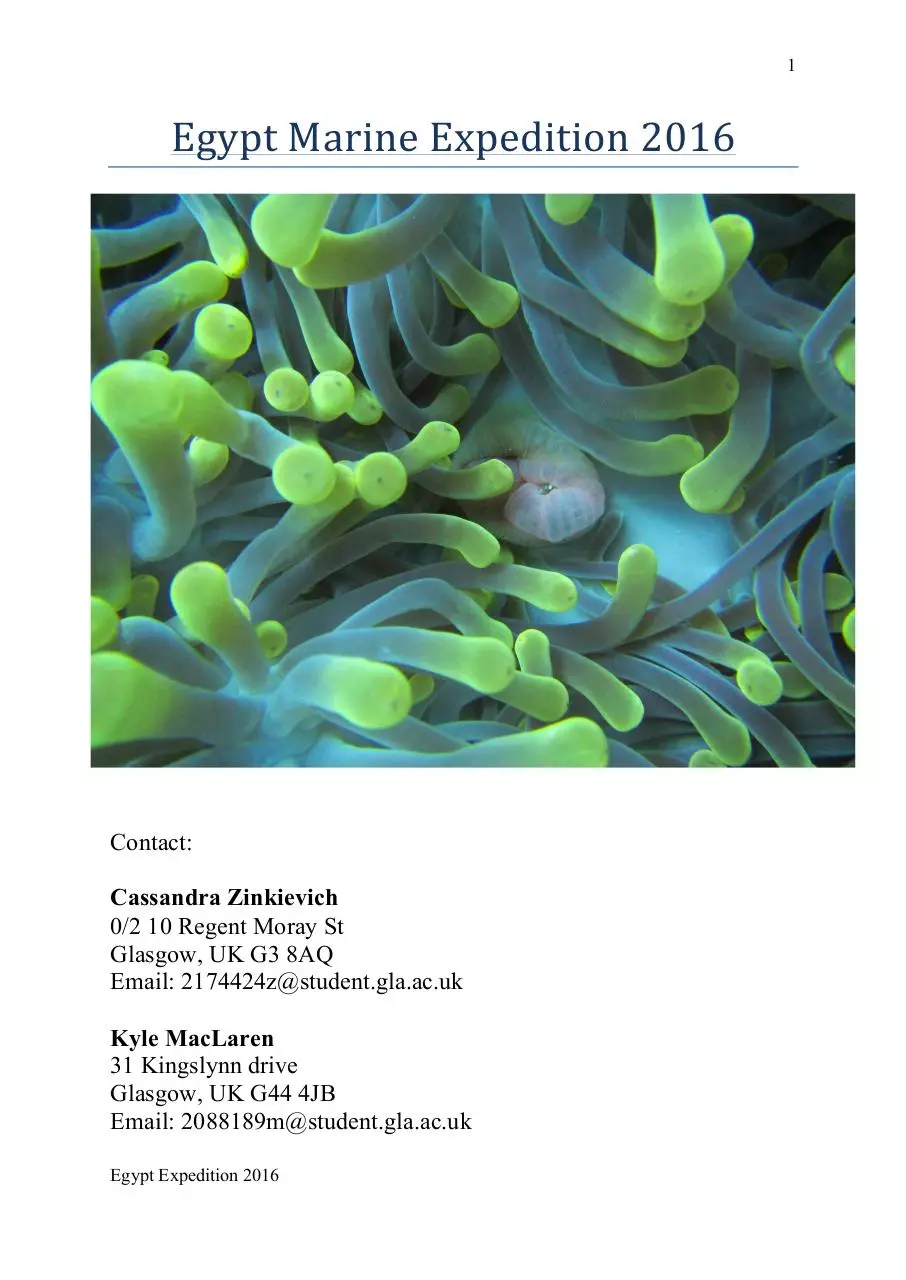
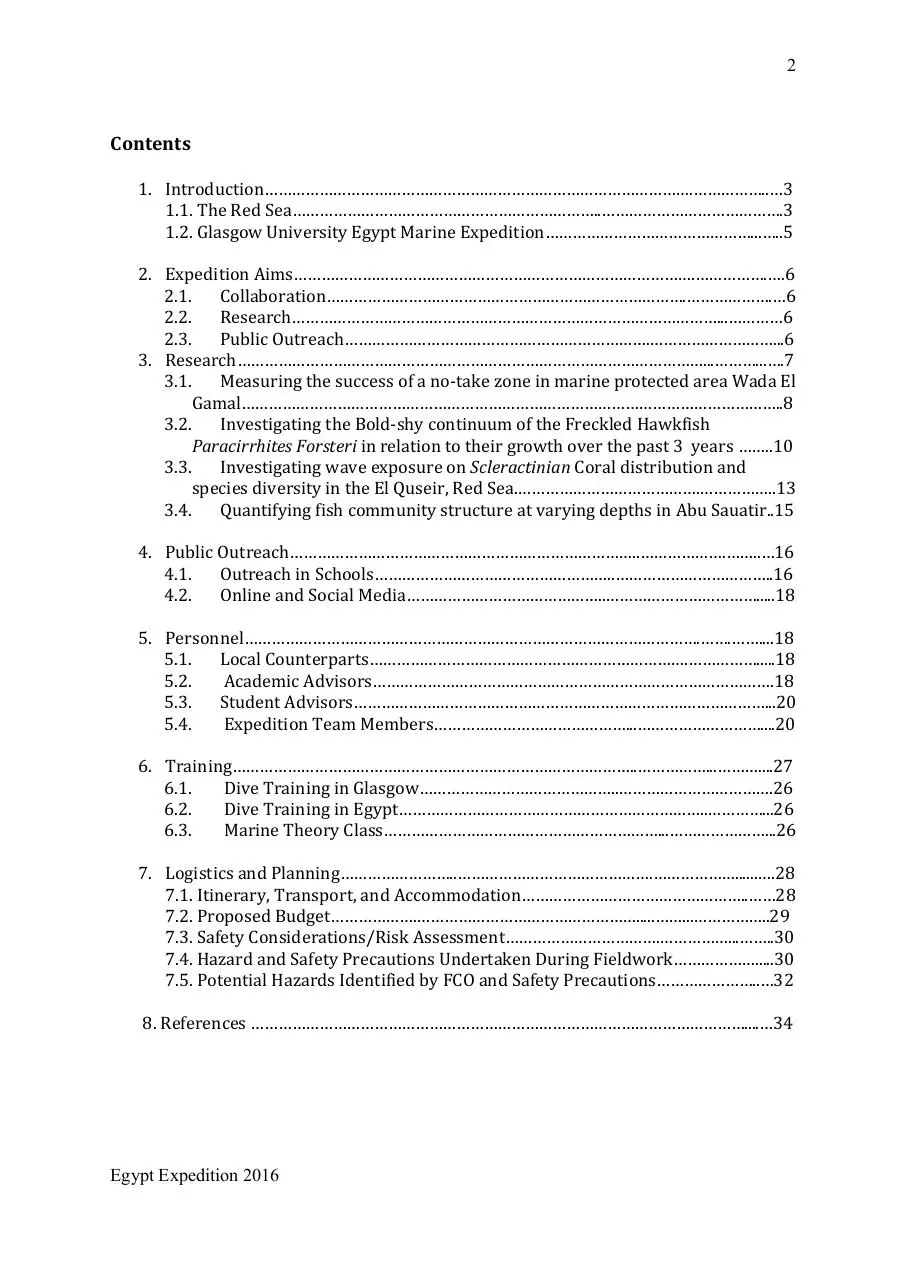
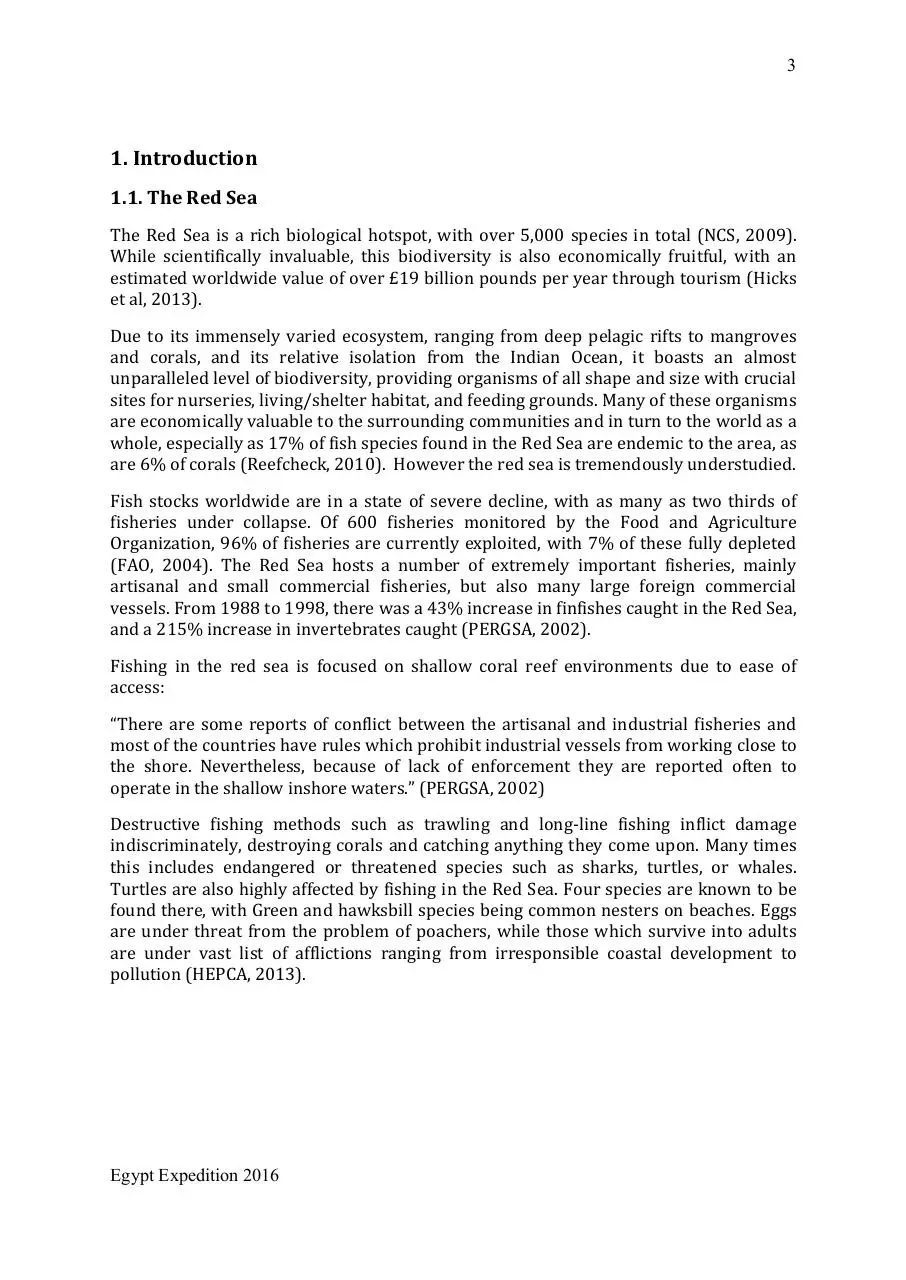
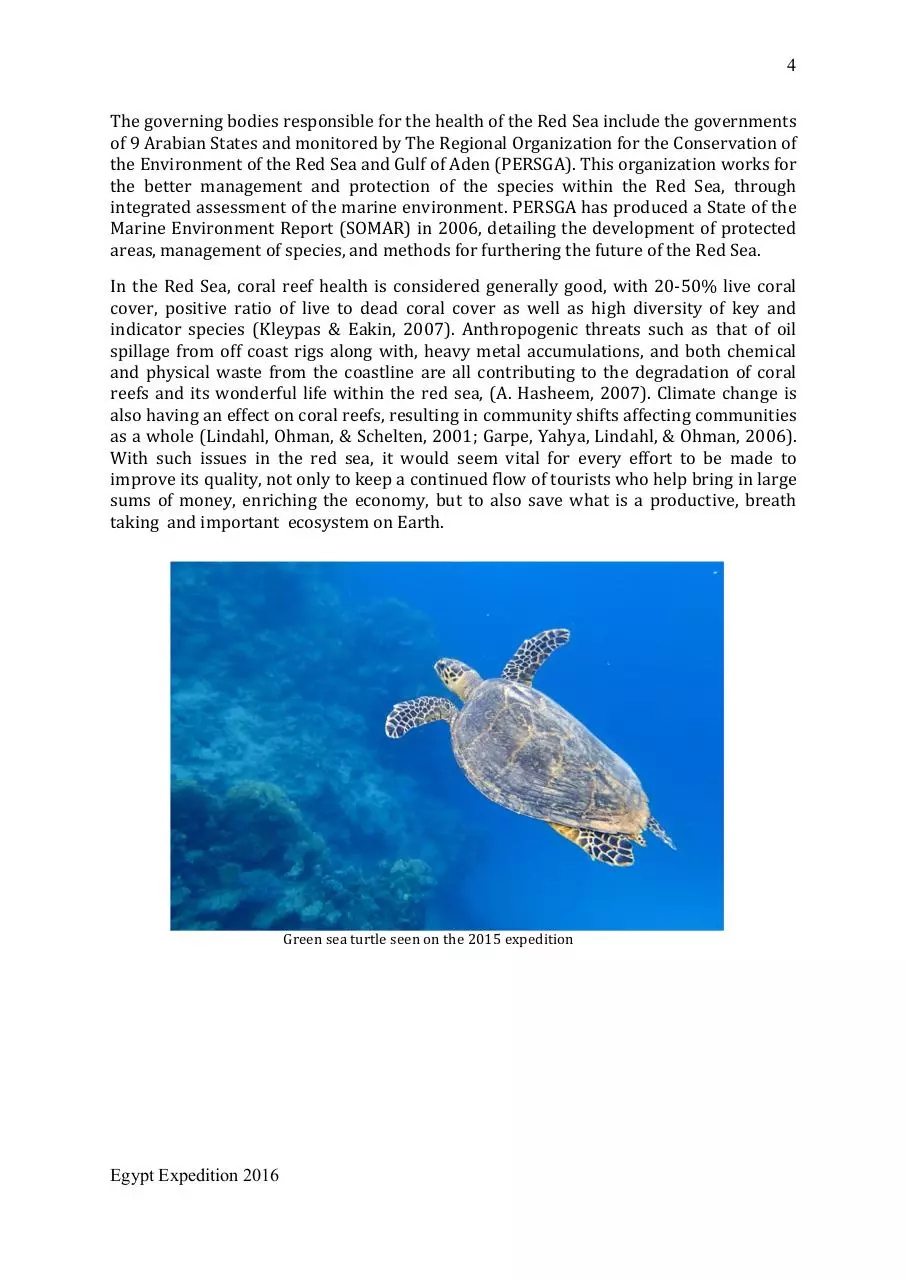
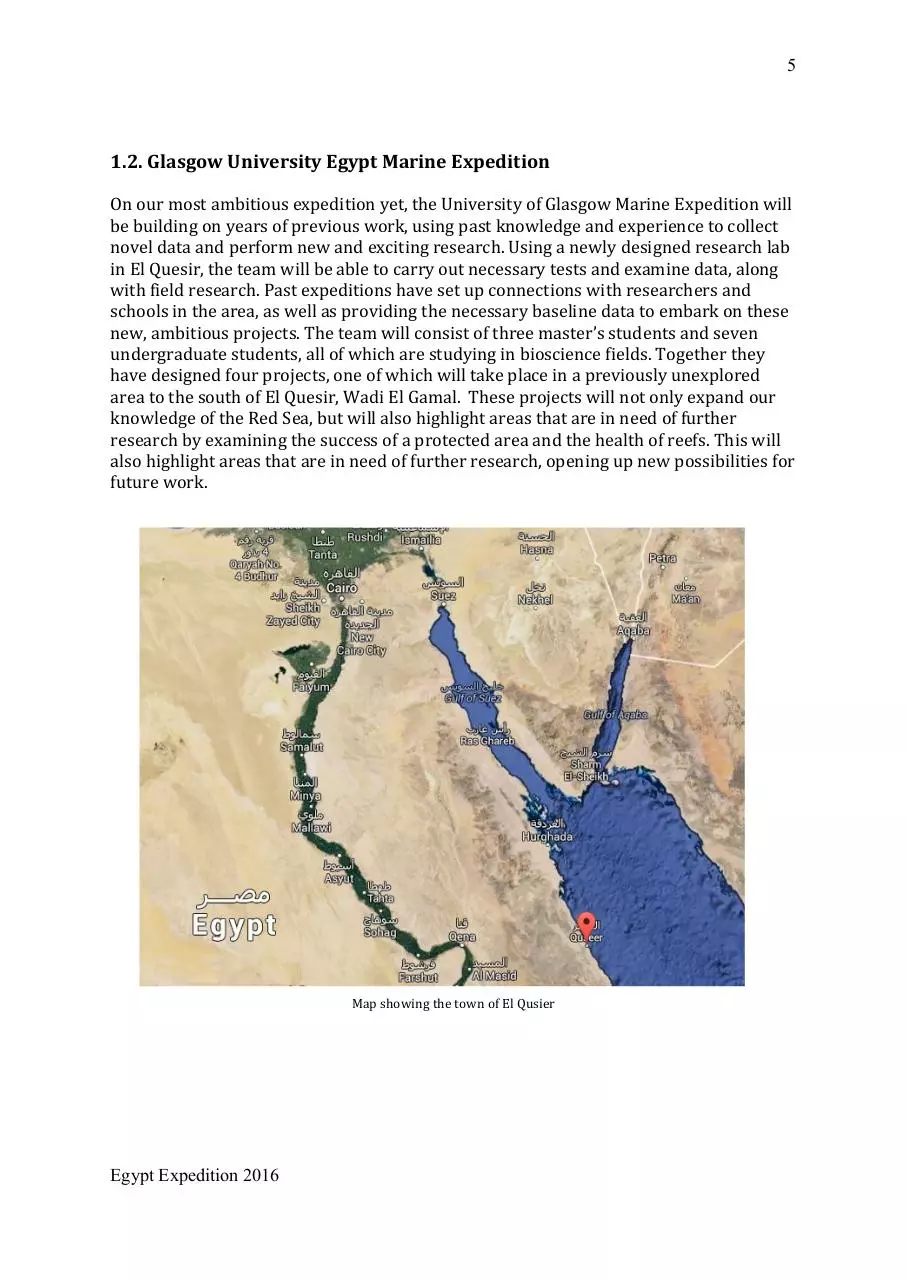
File preview
1
Egypt Marine Expedition 2016
Contact:
Cassandra Zinkievich
0/2 10 Regent Moray St
Glasgow, UK G3 8AQ
Email: 2174424z@student.gla.ac.uk
Kyle MacLaren
31 Kingslynn drive
Glasgow, UK G44 4JB
Email: 2088189m@student.gla.ac.uk
Egypt Expedition 2016
2
Contents
1. Introduction………………………………………………………………………………….……………..…3
1.1. The Red Sea…………………………………………………………..………………………………….3
1.2. Glasgow University Egypt Marine Expedition………………………………………...…..5
2. Expedition Aims…………………………………………………………………………….…………….….6
2.1.
Collaboration…………………………………………………………………….……………….…6
2.2.
Research…………………………………………………………………………………...…………6
2.3.
Public Outreach………………………………………………………….………………………...6
3. Research…………………………………………………………………………………………...………...….7
3.1.
Measuring the success of a no-‐take zone in marine protected area Wada El
Gamal………………………………………………………………………………………………………..8
3.2.
Investigating the Bold-‐shy continuum of the Freckled Hawkfish
Paracirrhites Forsteri in relation to their growth over the past 3 years ……..10
3.3.
Investigating wave exposure on Scleractinian Coral distribution and
species diversity in the El Quseir, Red Sea.………………………………….……………..13
3.4.
Quantifying fish community structure at varying depths in Abu Sauatir..15
4. Public Outreach…………………………………………………………………..……………….……..…16
4.1.
Outreach in Schools……………………………………………..……………………………..16
4.2.
Online and Social Media……………………………………..…………………………….....18
5. Personnel……………………………………………………………………………………….…….……....18
5.1.
Local Counterparts…………………………………………………………….…………….....18
5.2.
Academic Advisors…………………………………………………………………………….18
5.3.
Student Advisors………………………………………………………………………………...20
5.4.
Expedition Team Members……………………………………...………………………....20
6. Training……………………………………………………………………………..……………...………....27
6.1.
Dive Training in Glasgow……………………………………..…………………………….26
6.2.
Dive Training in Egypt…………………………………………………………..…………...26
6.3.
Marine Theory Class……………………………………………………...…………………...26
7. Logistics and Planning……………………..…………………………………….………………......….28
7.1. Itinerary, Transport, and Accommodation…………………………………………..……28
7.2. Proposed Budget……………….………………………………………….....……...……………..29
7.3. Safety Considerations/Risk Assessment…………………………….……………...……..30
7.4. Hazard and Safety Precautions Undertaken During Fieldwork……………….....30
7.5. Potential Hazards Identified by FCO and Safety Precautions…………………..…32
8. References ………………………………………………………………………………………………....…34
Egypt Expedition 2016
3
1. Introduction
1. Introduction
1.1. The Red Sea
The Red Sea is a rich biological hotspot, with over 5,000 species in total (NCS, 2009).
While scientifically invaluable, this biodiversity is also economically fruitful, with an
estimated worldwide value of over £19 billion pounds per year through tourism (Hicks
et al, 2013).
Due to its immensely varied ecosystem, ranging from deep pelagic rifts to mangroves
and corals, and its relative isolation from the Indian Ocean, it boasts an almost
unparalleled level of biodiversity, providing organisms of all shape and size with crucial
sites for nurseries, living/shelter habitat, and feeding grounds. Many of these organisms
are economically valuable to the surrounding communities and in turn to the world as a
whole, especially as 17% of fish species found in the Red Sea are endemic to the area, as
are 6% of corals (Reefcheck, 2010). However the red sea is tremendously understudied.
Fish stocks worldwide are in a state of severe decline, with as many as two thirds of
fisheries under collapse. Of 600 fisheries monitored by the Food and Agriculture
Organization, 96% of fisheries are currently exploited, with 7% of these fully depleted
(FAO, 2004). The Red Sea hosts a number of extremely important fisheries, mainly
artisanal and small commercial fisheries, but also many large foreign commercial
vessels. From 1988 to 1998, there was a 43% increase in finfishes caught in the Red Sea,
and a 215% increase in invertebrates caught (PERGSA, 2002).
Fishing in the red sea is focused on shallow coral reef environments due to ease of
access:
“There are some reports of conflict between the artisanal and industrial fisheries and
most of the countries have rules which prohibit industrial vessels from working close to
the shore. Nevertheless, because of lack of enforcement they are reported often to
operate in the shallow inshore waters.” (PERGSA, 2002)
Destructive fishing methods such as trawling and long-‐line fishing inflict damage
indiscriminately, destroying corals and catching anything they come upon. Many times
this includes endangered or threatened species such as sharks, turtles, or whales.
Turtles are also highly affected by fishing in the Red Sea. Four species are known to be
found there, with Green and hawksbill species being common nesters on beaches. Eggs
are under threat from the problem of poachers, while those which survive into adults
are under vast list of afflictions ranging from irresponsible coastal development to
pollution (HEPCA, 2013).
Egypt Expedition 2016
4
The governing bodies responsible for the health of the Red Sea include the governments
of 9 Arabian States and monitored by The Regional Organization for the Conservation of
the Environment of the Red Sea and Gulf of Aden (PERSGA). This organization works for
the better management and protection of the species within the Red Sea, through
integrated assessment of the marine environment. PERSGA has produced a State of the
Marine Environment Report (SOMAR) in 2006, detailing the development of protected
areas, management of species, and methods for furthering the future of the Red Sea.
In the Red Sea, coral reef health is considered generally good, with 20-‐50% live coral
cover, positive ratio of live to dead coral cover as well as high diversity of key and
indicator species (Kleypas & Eakin, 2007). Anthropogenic threats such as that of oil
spillage from off coast rigs along with, heavy metal accumulations, and both chemical
and physical waste from the coastline are all contributing to the degradation of coral
reefs and its wonderful life within the red sea, (A. Hasheem, 2007). Climate change is
also having an effect on coral reefs, resulting in community shifts affecting communities
as a whole (Lindahl, Ohman, & Schelten, 2001; Garpe, Yahya, Lindahl, & Ohman, 2006).
With such issues in the red sea, it would seem vital for every effort to be made to
improve its quality, not only to keep a continued flow of tourists who help bring in large
sums of money, enriching the economy, but to also save what is a productive, breath
taking and important ecosystem on Earth.
Green sea turtle seen on the 2015 expedition
Egypt Expedition 2016
5
1.2. Glasgow University Egypt Marine Expedition
On our most ambitious expedition yet, the University of Glasgow Marine Expedition will
be building on years of previous work, using past knowledge and experience to collect
novel data and perform new and exciting research. Using a newly designed research lab
in El Quesir, the team will be able to carry out necessary tests and examine data, along
with field research. Past expeditions have set up connections with researchers and
schools in the area, as well as providing the necessary baseline data to embark on these
new, ambitious projects. The team will consist of three master’s students and seven
undergraduate students, all of which are studying in bioscience fields. Together they
have designed four projects, one of which will take place in a previously unexplored
area to the south of El Quesir, Wadi El Gamal. These projects will not only expand our
knowledge of the Red Sea, but will also highlight areas that are in need of further
research by examining the success of a protected area and the health of reefs. This will
also highlight areas that are in need of further research, opening up new possibilities for
future work.
Egypt Expedition 2016
Map showing the town of El Qusier
6
2. Expedition Aims
2.1. Collaboration
The team will be working in collaboration with contacts from the Egypt Environmental
Affairs Agency (EEAA), Society of Environmental Awareness Supporters (SEAS), ROYAA,
Hurghada Environmental Protection & Conservation Association (HEPCA), and Keep
Quesir Beautiful (KQB). These organizations mainly focus on conservation and
environmental issues, and aim to educate and inspire people to care for the
environment. These contacts will not only assist with the expedition, but also give us a
chance to reach out to the community and share our knowledge and facilitate events
such as beach cleanups. Working with these organizations in the past has been
rewarding for both the team members and the community, allowing members to get
involved in the teaching of children about the ocean.
We will also liaise with The Open Ocean Science Centre (OOSC), an NGO based in Dahab
and El Quseir. We will also be arranging transportation through the Pharaoh Dive Club
and Roots camp. The OOSC will provide general logistical support, assistance in
acquiring the necessary permits from the local authorities, and transport between El
Quseir and Wadi El Gamal for the team members carrying out the Marine Protected
Area research project. By collaborating with groups like the OOSC, we are able to
strengthen the University’s reputation as an international research body, while also
benefiting from the insider expertise of local people.
2.2. Research
The goal of the 2015 Egypt Expedition is to conduct four research areas (detailed
below) that will focus on conservation and the continuation of previous studies. Each
project will be designed and carried out by one or two members of the expedition, but
all team members will fully understand and be involved in all of the projects. Projects
will be carefully planned with the aid of an academic supervisor, who will ensure that
each one will meet its goals and will produce high quality research. The expectation is to
have most, if not all, of the projects be of publishable quality, and to have them
published in a respected journal. This not only benefit the university, but also prepare
the expedition members for a future in research, enabling expedition members to make
a contribution to the scientific community and increase the repute of the Glasgow
University Expedition Society. We aim to report our results by means of our blog, poster
presentations, attending seminars and conferences and by compiling a comprehensive
report of our findings.
2.3. Public Outreach
The past three expeditions have established many useful connections not only at home,
but in Egypt-‐ these connections include NGOs and Universities and, importantly,
primary schools. As a team, we recognise the importance of sparking an interest in the
natural world among the next generation of biological scientists. Although we will
Egypt Expedition 2016
7
unfortunately not be able to return to Hillhead Primary as we have in recent years due
to the timing of the expedition interviews, we are planning to work with schools in El
Quesir. We will work with the children to teach them the importance of the ocean and
the conservation of its biodiversity through interactive workshops, as well as engaging
in beach clean-‐ups and snorkeling. These events have been very well received in the
past, and have been rewarding for both the schoolchildren and expedition members.
We also will keep in touch with our followers through weekly updates on our website
(http://www.gu-‐egypt-‐expedition.co.uk/), as well as our popular Facebook page (610
likes) and Twitter. These updates will not only focus on the team and expedition, but
also relevant news from the world of marine conservation biology.
3. Research
The following research areas will encompass no fewer than two and no more than four
individual projects on coral reef ecosystems. Each study has been developed to suit the
research interests of its particular student coordinator, whilst attempting to further
develop some of the questions posed during reviews of the results from the Egypt 2015
expedition, and take into account questions arisen from the annual tropical ecology field
course undertaken by the University of Glasgow.
Egypt Expedition 2016
8
3.1 Measuring the success of a no-‐take zone in marine protected area Wada
El Gamal
Introduction:
Marine protected areas, and specifically no-‐take zones (NTZs), are becoming an
increasingly important part of marine conservation, with as many as 5,880 marine
reserves around the world today (Bergseth, Russ, & Cinner 2013). There is a wealth of
evidence that no-‐take zones provide both social and biological benefits; not only
maintaining and improving ecosystem health but also benefitting the communities that
depend on them (Pomeroy et al. 2005, Advani et al. 2015, Rife 2013, Halpern & Warner
2002). Overexploited target species are given an opportunity to recover, as are habitats
that may have been destroyed from destructive fishing practices such as trawling or
dynamite fishing. Surrounding take zones are also improved due to the migration of fish
and larvae from the NTZ, replenishing fish stocks in these fished areas (Ashworth&
Ormond 2005). However, NTZs can be rendered ineffective if managed and monitored
improperly. A study of 1,306 marine protected areas in 1995 showed that only 31%
believed they had reached their management goals (Jameson, Tupper & Ridley 2002),
and it is well documented that the majority of marine protected areas are not successful
(Pomeroy et al. 2005, Rife et al. 2013). Failure of no take zones is mostly due to
insufficient monitoring, poor funding, and lack of compliance from fishermen (Advani et
al. 2015).
There is very little data available on the state of Red Sea fisheries (FAO 2014), and even
less on the status of marine protected area and NTZ Wadi El Gamal. Wadi El Gamal is
large (1,600km2), well funded (€131,750 yearly from a variety of parties) and is both
staffed and monitored by an NGO called HEPCA (Hurghada Environmental Protection
and Conservation Association) (Samy, Lizaso&Forcada2011). Wadi El Gamal is also
sparsely featured in Red Sea conservation literature. Our research would summarize the
NTZ’s success in this MPA, facilitating comparison to other MPAs in Egypt and abroad,
and aiding Egyptian stakeholders in policymaking, development and future
conservation work. Extensive literature surrounding no-‐take zones is vital if we are to
critically examine our frameworks for marine biodiversity conservation, and design
viable future projects.
Aims:
This project will adapt and expand upon the research of Advani et al. (2015),
investigating whether individual fish size, fish biomass, abundance, and species richness
are higher within the no take zone compared to the fishing zones. We will also note the
presence of discarded fishing gear, as an indicator of compliance to regulation.
Methodology:
Four researchers will travel by Mini bus provided by Roots Camp and Pharaoh Dive
Club to Wadi El Gamal and camp for 5 days at a time, and will then return to El Quesir
for 2 to 3 days to refresh supplies, enter data and participate in other project work. The
trip will occur a total of 4 times, resulting in a total of 20 days camping in Wadi El Gamal
and the surrounding take zones. We will be working with EEAA and local counterparts
from ROYAA, SEAS, HEPCA, and Suzanna Aprille Valle.
Egypt Expedition 2016
9
Three sites will be chosen in no-‐take zone Wadi El Gamal, along with three sites in each
of two neighbouring fishing zones. At all nine sites, two observers will carry out four
25m long belt transects: two at 3m depth-‐ representative of reef crest depth, where
herbivorous fish are mostly caught (Advani et al. 2015); and two at 10m depth-‐ or reef
slope depth, where predatory fish are mostly caught (ibid). Each site’s two transects will
be repeated three times, at different hours on two non-‐consecutive days, to avoid the
effect of time of day on the marine community structure. Each observer will be trained
to recognize a group of fish families, avoiding pseudoreplication. In total, this will
require 54 dives. The dives will occur three times a day over 20 days, which will allow
us 60 dives. This will allow us a two-‐day buffer, in case of injury or illness. With the use
of computer software, the stereoscopic cameras will allow fish size to be calculated in
order to determine biomass from publicly available length to weight data. To measure
species richness and biodiversity, researchers will use the film to identify fish by trophic
level and family. Trophic levels observed will consist of: herbivores, omnivores,
corallivores, invertivores, and piscivores. Fish families that will be identified are:
Epinephelidae, Lutjanidae, Lethrinidae, Chaetodontidae, Pomacanthidae, Scaridae,
Acanthuridae, and Siganidae. It is necessary to identify trophic level along with family as
lower trophic levels will experience different fishing pressures than higher tropic levels,
and will respond differently to no-‐take zones. Divers will also record instances of
discarded fishing gear and compare them between sites. This will be done by
photographing the gear, and recording the location and photo number of the gear on a
dive slate. Any results will be written into a log book after each dive, and will be entered
into an excel spreadsheet upon our return to El Quesir. In a healthy reef system, we
would expect to find an increase in large, piscivorous fish due to relief from fishing
pressures. Smaller, herbivorous fish that are less commercially important may show
little change or even an opposite effect due to increased predation from piscivores
(Halpern & Warner 2002, Advani et al. 2015, Ashworth & Ormond 2005). The increase
in large piscivorous fish, along with a larger fish population, will also lead to an increase
in fish biomass. We would also expect to find lower instances of discarded fishing gear.
A map of Wadi El Gamal National Park
Egypt Expedition 2016
Download Egypt Prospectus 2016
Egypt Prospectus 2016.pdf (PDF, 5.02 MB)
Download PDF
Share this file on social networks
Link to this page
Permanent link
Use the permanent link to the download page to share your document on Facebook, Twitter, LinkedIn, or directly with a contact by e-Mail, Messenger, Whatsapp, Line..
Short link
Use the short link to share your document on Twitter or by text message (SMS)
HTML Code
Copy the following HTML code to share your document on a Website or Blog
QR Code to this page

This file has been shared publicly by a user of PDF Archive.
Document ID: 0000333217.